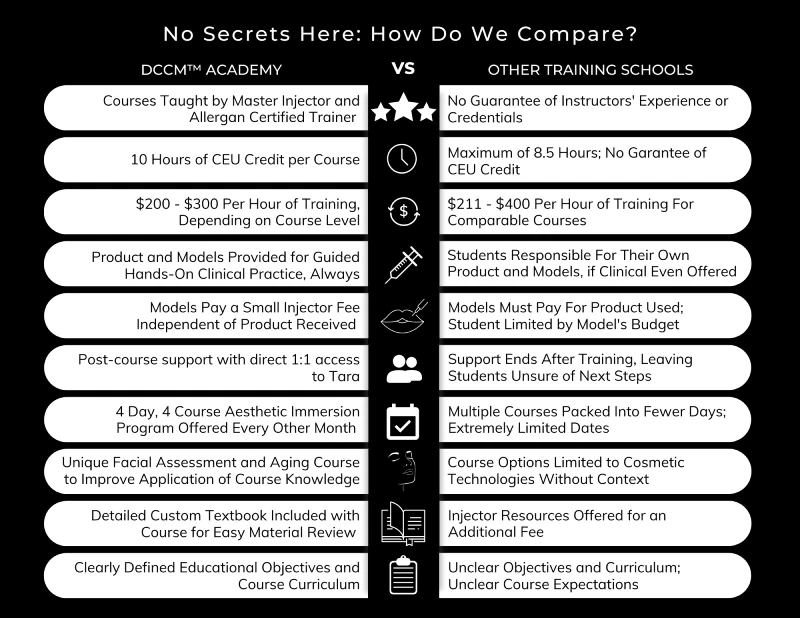Guide to Aesthetic Nursing
What Is an Aesthetic Nurse?
How Do I Become an Aesthetic?
What Does an Aesthetic Nurse Do?

What Are the Educational Requirements to Become an Aesthetic Nurse?
What is an Aesthetics Nurses Salary?
How Long Does it Take to Become an Aesthetic Nurse?
Do I need to have a Medical Director?
What type of Insurance Does an Aesthetic Nurse Need?
An aesthetic nurse needs to have basic malpractice insurance. In addition, they must request to add on each specialty aesthetic service they provide.
We recommend Professional Insurance Solutions 1-888317-4689, ben@psisolutionspro.com.
For more information regarding launching your career as an aesthetic nurse, visit our website at www.dccmacademy.com, or you may email info@dccmacdemy.com.
At DCCM™ Academy, we offer a variety of learning opportunities:
Offerings at DCCM™ Academy
- Neuromodulation Courses
- Dermal Filler Courses
- Facial assessment Courses
- Lip Filler Course
- Adverse Event Management Courses
- Private Training
- 6 Month Fellowship
- Observation Days
- Free articles written by Tara
- Published book on Neuromodulation
- Mentorship Program
- Complete Compliance Package of Policies and Procedures, Consents, Vascular Occlusion Policy, and more.
- Aesthetic Immersion Course (4 days packed full of learning).


Tara Delle Chiaie
My name is Tara and I am the owner of Delle Chiaie Cosmetic Medicine. I have been in medicine since 2002 as a Registered Nurse. In 2011 I graduated from the accelerated program at the University of New Hampshire (UNH) as an Advanced Practice Registered Nurse (APRN). My goal is to continually fine-tune the art of bringing one’s inner beauty to the surface.
2023 Course listings
- January 3rd-6th
- March 7th-10th
- May 2nd-5th
- August 1st-4th (Sold Out)
- September 5th-8th
- November 7th-10th
MEET
Tara Delle Chiaie
DNP, MSN, FNP-BC, APRN, ABAAHP
Owner/Master Aesthetic Injector
My name is Tara and I am the owner of Delle Chiaie Cosmetic Medicine. I have been in medicine since 2002 as a Registered Nurse. In 2011 I graduated from the accelerated program at the University of New Hampshire (UNH) as an Advanced Practice Registered Nurse (APRN) and immediately became nationally recognized through the American Nurses Credentialing Center (ANCC) as a Board Certified Nurse Practitioner. I grew up in the beauty industry and found it was a great union to blend beauty with medicine. I have an astute sense of safety, while my experience guides my practice to produce beautiful and natural results. My goal is to continually fine-tune the art of bringing one’s inner beauty to the surface.


Let's Talk About
Your Career
*By submitting this form you agree to be contacted by DCCM Academy
and receive marketing messages by phone, text, or email. You can unsubscribe from these communications at any time. We commit to protecting and respecting your privacy. For more information, please review our Privacy Policy.

